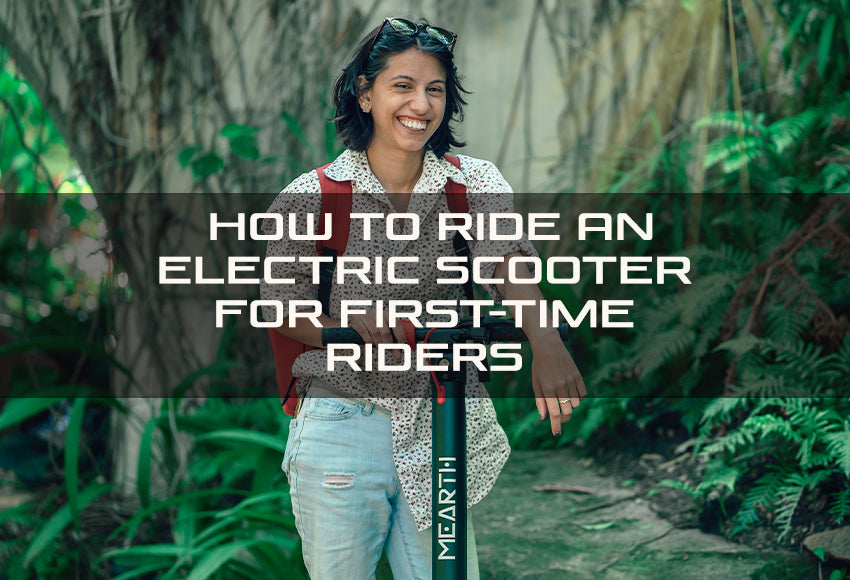
Watching other people ride electric scooters makes it seem fun and easy—and it is! However, some people, especially beginners, may have a tricky time getting used to getting on an e-scooter and riding one.
If you're a first-time electric scooter rider, this guide will walk you through everything that you need to know, from before riding an e-scooter to after riding it. This ensures that you can ride safely and confidently on the e-scooter. So, here’s how to ride an electric scooter for first-time riders
What to do before riding an electric scooter
Keep the following tips in mind before riding an e-scooter to protect yourself from risk or danger.
1. Check the condition of your e-scooter
Whenever you ride an electric scooter, always make sure to check the condition of the components of your e-scooter. Here’s a quick checklist:
- Good tyre pressure and no tyre damage
- Strong braking power
- Stable folding mechanism
- Full battery level
- Steady acceleration
- No weird noises and no obvious damage
If your e-scooter is in good condition, then you are good to go.
2. Learn the parts of your e-scooter
While checking your electric scooter, it’s also a good opportunity to learn its different parts and controls. If you’re not sure what you’re looking at here’s a helpful overview of the different parts of an electric scooter.
Specifically, learn how the controls on the deck work. What does each button or throttle do? How does the folding mechanism work? How does the foot brake work? Make sure to know every bit of your e-scooter, so you know how exactly it works and which parts you should be mindful of.
3. Prepare your protective gear
Finally, before getting on your e-scooter, always wear your protective gear. The most important gear that you could wear is a helmet since it will protect you in case of falling or collision. Aside from this, riders are encouraged to wear elbow and knee pads and gloves for extra protection. When riding at night, it’s recommended to wear a reflective vest or attach lights to your helmet to make you more visible to pedestrians and other vehicles.
How to ride an electric scooter
To help you ride an e-scooter properly and safely, follow the following electric scooter riding tips.
1. Place the electric scooter on a flat surface
Start by placing your unfolded e-scooter on a flat surface. It’s recommended to practice riding on flat surfaces at first to get the feel of riding the e-scooter. Next, raise the kickstand beside the deck just before you take off. The e-scooter will lean without the kickstand, so make sure to hold on to it and support it.
2. Place one fit on the deck and kick to launch forward
Place your weak leg on the deck and the strong leg on the flat surface. Make sure your feet are facing forward. Also, hold the handlebars with both hands and lean forward. That’s your starting position.
When you’re ready, let your strong leg kick or push away to launch the e-scooter forward. Quickly place the strong leg behind your weaker leg. Place it comfortably to stabilise your position. This position will help you balance the e-scooter and minimise your size. That’s how to start an electric scooter correctly.
3. Accelerate slowly
As soon as you kick forward, you also push the throttle or button simultaneously. However, be careful not to push the acceleration too much to avoid suddenly speeding off. As you are still learning, go slow and steady. E-scooters have different speed modes, so make sure to use the lowest speed mode while practising.
4. Learn to balance and stabilise yourself
As you ride slowly, learn to balance yourself on the e-scooter and get a feel of how to ride your e-scooter. When turning, practise turning the handlebar and shifting your weight to maintain balance. Also, whenever you ride an e-scooter, remember to never ride with one hand. Always keep both hands on the handle, so you can turn away in case of sudden collisions.
Also, remember that the handlebars are there to provide support. If you’re pushing or pulling hard on the handlebars, this means you need to learn how to balance yourself. To balance yourself, use your legs. That’s why you need to stand in the proper position (weak leg in front, strong leg behind) to have a stable standing position.
Finally, learn to shift your forward when accelerating and backward when braking. This allows you to distribute your weight evenly on the e-scooter and prevent you from going out of balance and falling off the e-scooter.
5. Learn how to stop properly
Knowing how to stop properly can prevent you from jerking hard when stopping and possibly falling off the e-scooter. When braking, always bend your knees to protect them and shift your weight back. Practice this stance when braking so that it becomes second nature.
Also, avoid braking hard while turning as it can cause you to fall or crash. Instead, try to straighten up then brake for a more stable and safe brake. Test and practise your e-scooter’s braking power, so you can be familiar with how hard you need to brake during certain situations.
6. Look ahead when riding
When you’re already used to riding your electric scooter, it’s time to practice looking ahead and being aware of your surroundings while riding. Some beginners tend to look at the handles while riding, but that’s not good practice. Your eyes should always be on the road and nowhere else, so you can see where you are going.
While riding, pay attention to the pedestrians and always give way to them. Moreover, be mindful of other riders and vehicles if you are riding near the street. It’s also important to be aware of the road surface so you can prepare yourself if the road is uneven or slippery.
Practise quickly avoiding obstacles by making small controlled movements. Knowing your way around different paths will help you keep safe when riding in public. Finally, learn the e-scooter rules in your city. Don’t ride one in public if it’s not allowed.
What to do after riding an electric scooter
Here are tips to take care of your electric scooter after riding.
1. Fold and carry your e-scooter
After riding, make sure to fold your e-scooter to save space or make it easy to carry in public. Thankfully, since most commuter e-scooters are light and compact, you can carry them even inside public transportation. Just make sure to be extra mindful when bringing them inside crowded spaces so you don’t hit, bump, or block people. Here’s a helpful guide on how to bring your e-scooter in public.
2. Secure your e-scooter
If you can’t bring your e-scooter inside your home or establishment, make sure it’s safe and secure before leaving it outside. Invest in a good bicycle or e-scooter lock, so you can prevent your e-scooter from getting stolen. There are different locks that you can choose from, but choosing the right one will help you secure your e-scooter better. Here’s how to pick the best lock for your e-scooter.
3. Clean it before storing
Before storing, make sure to clean your e-scooter first. You don’t have to wash it every time you ride, but a simple wiping with a damp towel can help maintain its good condition. When it comes to cleaning your electric scooter thoroughly, it’s best to wash it once or twice a month, depending on how dirty your electric scooter gets.
When washing, be careful with how much water you use to avoid splashing water inside the electrical components of your e-scooter. For a detailed guide on cleaning your e-scooter, check out this thorough guide.
4. Store it properly
After making sure that your e-scooter is clean and dry, you can now store it inside a box, shed, garage, or even cabinet. Electric scooters are quite compact when folded, so you can store them in small or tight spaces.
When storing, place it inside a space that is clean and free from dust. In this way, you prevent any clutter, dust, or dirt from entering the e-scooter components. Moreover, avoid storing the e-scooter in a space that’s too hot or too cold, as it can affect the battery capacity and performance of the e-scooter. This electric scooter guide can help you store your e-scooter properly to maintain and prolong your e-scooter’s lifespan.
Have fun riding!
Remember to take your time when learning how to ride an electric scooter. If you are having a difficult time riding it, it’s best to practice riding it within a safe space before riding it in public. Once you’re confident and stable enough to ride in public, go ahead and enjoy your trips! Just remember to apply the safety tips above for a worry-free ride.
Hopefully, this guide on riding an electric scooter for beginners has helped you learn the proper and safe way to ride an e-scooter. For more electric scooter tips and tricks, check out Mearth’s blogs.




Leave a comment
This site is protected by hCaptcha and the hCaptcha Privacy Policy and Terms of Service apply.